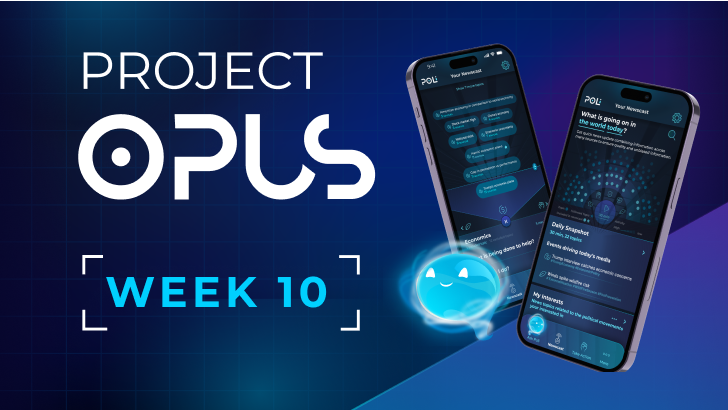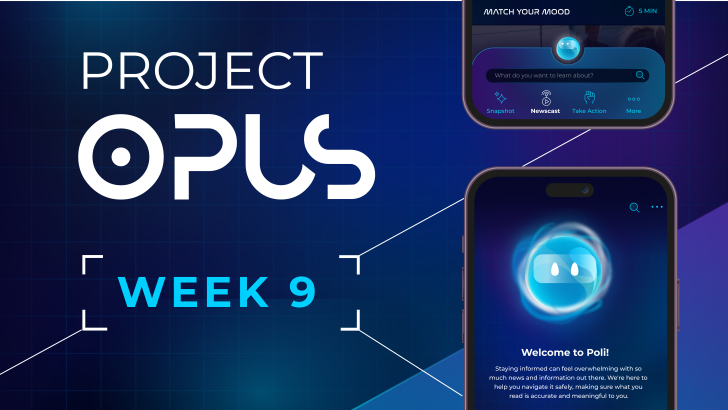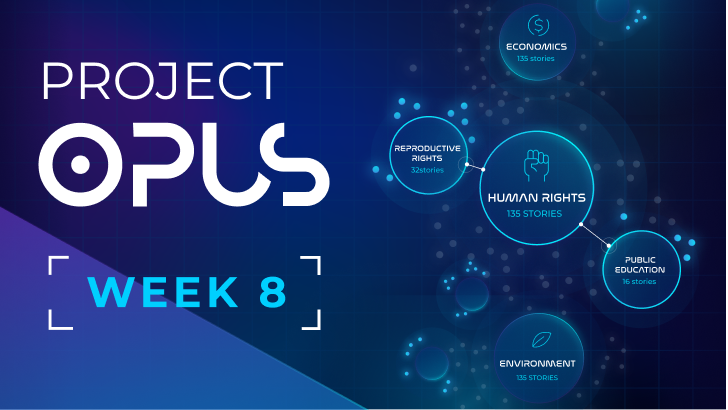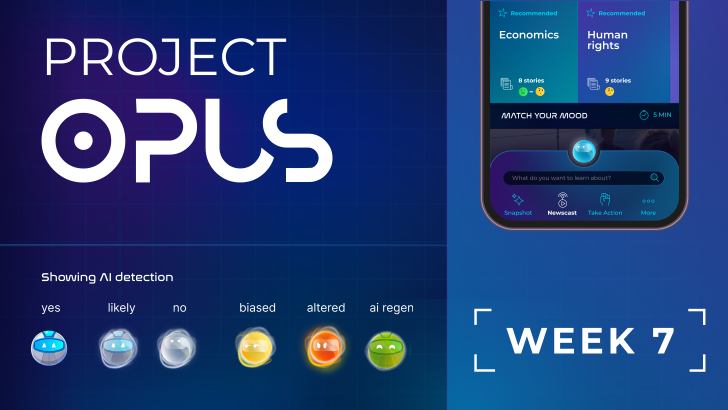As a product design agency, we collaborate with industry leaders to create innovative solutions, but rarely do we get the chance to create something entirely from scratch with zero constraints. Project Opus is that rare opportunity.
Over the next 10 weeks, our team of designers, researchers, strategists and marketers will be collaborating on a moonshot project—an internally driven effort to conceptualize and design a new AI product from the ground up with no limitations. We’re bringing you along for every step of the journey. We’ll be documenting and sharing the entire design process, from defining the solution and idea generation, to user research and refinement.
You get a front row seat to our crazy ideas and real-time evolution as we apply our in-house process, the Innovation Equation™. We’re sharing it all—the wins, challenges, pivots, and even internal reviews.
Follow the project’s evolution through weekly videos on our LinkedIn and in-depth posts, like these, right here on our website.
So, what’s the project? Introducing Project Opus.
- Codename: Opus
- Timeline: 10 weeks
- Deliverables:
- Product definition and strategy
- User experience and interaction design
- Two rounds of user research
- Visual design strategy and UI design
- Interactive prototype
- Weekly documentation of our process and learnings
- Product Concept: A personalized control panel that offers a “safe space” for users to engage with AI as they interact with digital content in their daily lives. The solution should empower users to identify, control, and understand AI-generated material.
- Goal: It’s a 2-part mission.
- By the end of 10 weeks, we will have a product design and working prototype of this conceptual AI product grounded in user and market needs
- We’re also using this exercise to pressure test our newly developed product invention process, the Innovation Equation™.
We hit the ground running this week, accomplishing a lot in just 5 days: Project Kickoff, Product Definition, Potential Target Market Exploration, and defining initial needs based on Innovation Building Blocks.
Our focus was to get aligned and start defining what we wanted to create. Here’s a look at what happened during Week 1.
We kicked the project off by introducing the team to a high-level view of the problem space, timeline, and goals for the coming weeks. Select members came with initial research of competitors and common interaction models in security software (a model of detection we are using as a starting point for ideation), and visual trends. It set the stage and gave the team a jump on the landscape before the official product definition meeting.
Starting with a broad product concept (defined in the overview above) gives us a general direction to pursue, but allows an inventive solution to emerge naturally through the Innovation Equation™ activities in the coming weeks.
“It'll be challenging to create a product that provides real value to users and isn't just another AI "thing" out there. I think some of the users who would benefit most from this type of product will also be the most hesitant to use it, so navigating those complex emotions will be tough but exciting to tackle." –Sarah Field, Product Manager & Designer
Because we are starting with a vague concept that could be taken a lot of different directions, we needed to identify the overarching objectives the product needs to achieve to be successful in business, to users, and in our own minds. These success criteria act as our reference point and source of truth as we move through different brainstorming and design activities, allowing us to ask ourselves, “Is this achieving what we set out to do?”
We also started identifying potential target markets and use cases.
Key meeting outcomes:
- Success Criteria
- Informed Interaction: Ensure users have a safe and informed way to engage with digital content, with the ability to know whether it is AI or human generated.
- Trustworthy Partner: Create a solution that acts as a reliable partner when navigating digital spaces.
- Empowering AI Use: Address user fears and confusion around AI and empower them to utilize AI in ways that are meaningful to them.
- Transparency and Minimalism: Offer transparent AI functionality with minimal disruption into daily life.
- Target Market Exploration: As a team we identified the following potential target markets and each member was assigned one to conduct foundational research on.
- Social, Politics, Health and Nutrition, Shopping, and Virtual Communication
Did we stick to our 90-minute meeting time to accomplish all this? No, no we did not. But the hours of collaboration that happened to lay this foundation was time well spent!
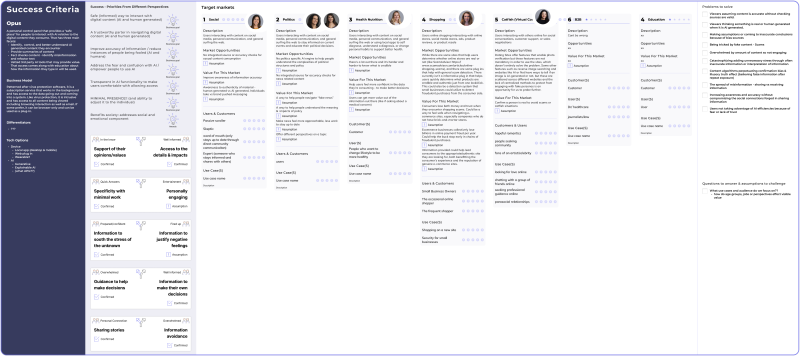
Product Definition exercises set the foundation for our project, giving us clearer markers to measure our progress against and a handful of potential use cases to begin exploring.
The team split up to conduct foundational research on each of the potential target markets: Social, Politics, Health/Nutrition, Shopping and Virtual Communication. The focus during this stage was to uncover the behaviors, emotions, and challenges users in each group face.
Findings were organized into what we call Innovation Building Blocks, modular pieces that help you manage and organize findings.
“There’s a lot of information that’s gathered during foundational research and user needs we find out about, but if they’re not recorded in a normalized way or someone’s left with that pile of research, it can be hard to know what to do with it and what information is important. Innovation Building Blocks are a guideline and a way for people to pull and keep track of the information that’s really going to help them create something new and exciting.” – Ashley Nicodemus, Process Lead
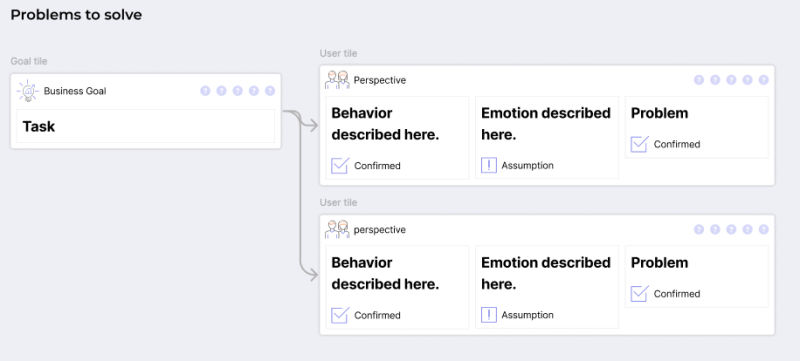
By the time Thursday rolled around, the team had already accomplished a lot. Our brainstorm kickoff was time to bring all the foundational research findings together. Everyone presented insights from their assigned market, sharing most common use cases, behaviors and emotions experienced by this group, common technology and devices they’re using, and how an AI product may offer value.
We uncovered 50+ common behaviors across these markets and identified tension points between shared themes and differing perspectives. We intentionally seek out these tension points because they make our ideation and brainstorming sessions richer. Instead of just solving for the most common theme, we challenge ourselves to think of as many ways as possible to address the needs of users with different goals and viewpoints to create an unexpected, one-of-a-kind solution.
Some of the differing perspectives identified:
- Those looking for quick and digestible information VS. those who want details and impact of information
- Those who want a quick answer VS. those who want to want material to be personally engaging
- Those who seek information to be prepared and feel confident VS. those who are prone to catastrophizing information
- Those who want guidance VS. those who like to make their own decision
- Those who like sharing stories VS. those who tend to be information avoidant
The foundational research led to a valuable discussion about how AI is experienced and interacts with the digital content consumed by people within our identified groups.
“The biggest insight was the amount of target markets that can be affected by our product. It's really interesting to find common themes against opposing markets, the biggest theme being logical fallacy and trying to address how it affects the way that humans react to information through behavior.” – Celeste Alcon, Senior UX Designer
And that brings us to today. You’re all caught up. We still have a lot of question marks around what our AI product can, and should, be but with each day it starts to take more shape.
A lot went down during week 1. It’s going to be a race to the finish line the next 9 weeks, and we’re looking forward to bringing you along for every step.
The team is off ideating MicroDesigns using the Innovation Equation™, and we’re coming back together next Wednesday to share ideas. Check back next week to see how the brainstorm activity went, and how it translates to some initial concept sketches.
As we know more, so will you. See you next week!

